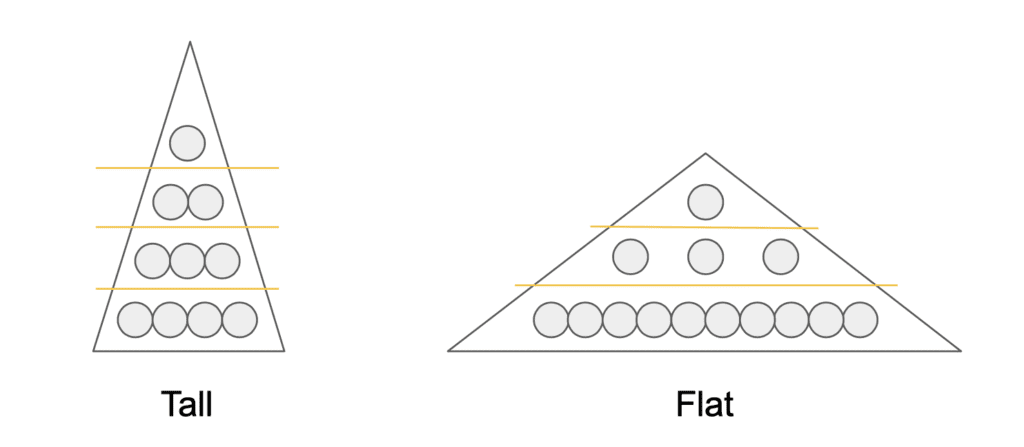Flat Vs Tall Organizational Structures
When your business grows, you add more people to the team. If you don’t add a management team, you’ll automatically grow a flat organization. Everybody in the firm is reporting to you. What are the problems with a flat structure. What are the benefits of a flat vs a tall organizational structure.
In this blog post, we will examine
- What a flat structure is
- What a tall structure is
- The pros and cons of both and
- How to make a flat organization work
Let’s go.

Span of control
Before we compare flat and tall structures, let’s first introduce the concept of span of control.
In simple terms, your span of control is the number of people that report to you. An example:
You lead a company with 10 employees and there are no other managers. Your span of control is 10.
Another example:
You lead a company of 20 people. 15 of them are led by two managers, the remaining three report directly to you. Your span of control is 5 (managers + staff level direct reports).
Flat versus tall organizational structure
A flat organizational structure features large span of control. A tall organizational structure has narrow span of control.
In other words: A tall organizational structure is more hierarchical, whereas a flat organizational structure requires higher autonomy.
Learn more about how we help clients with organizational structures:
Check out our Organizational Development Services
Pros of tall organizational structures
Tall organizational structures have their benefits. Here are some of them:
GOOD CAREER OPPORTUNITIES
If you have a tall structure, there will plenty of steps on the internal career ladder to climb for your most ambitious employees.
HIGH LEVEL OF CONTROL
With smaller spans of control, there’s more oversight for each individual employee.
MANAGEABLE LEADERSHIP TASKS
When you have a smaller number of people reporting to you, the workload stays manageable.
Cons of tall organizational structures
Tall organizational structures also have some well-know disadvantages:
TENDENCY TO DEVELOP SILOS
With tall organizational structures, you split up teams at the top of the organizational structures. This facilitates the creation of – usually undesirable – silos. Departments optimizing for their own success, without looking at the bigger picture or collaborating with other departments.
DETACHED AND SLOWER DECISION-MAKING
In tall structures, important decisions still have to be made by senior people. Many management levels in between the people closest to the problem (staff-level) and the people deciding (top management) can decrease decision quality and speed.
LEANER JOB PROFILES MIGHT BE UNATTRACTIVE
Sometimes, not always, taller structures have a stronger division of tasks. Job profiles are rather lean than rich. This might make the company less attractive to candidates looking for a job.
Pros of flat organizations
Flat organizations today are considered more desirable and functional. Let’s have a look why:
QUICK DECISION-MAKING
In flat organizations, the people that face a specific problem are more likely to have the authority to decide how to solve it.
Think about it this way:
In the ideal flat organization, there’s only one boss. All the rest of the team reports to her. Unless the CEO wants to decide everything herself, the person on the staff level will have decision power. Or at least will be the one preparing the different options for the CEO to pick from.
You don’t have to navigate multiple levels of hierarchy before coming to the person or committee that can make a decision. So you save a great deal of time.
GOOD FOR COMPLEX PROBLEM-SOLVING
Partly for the same reason, flat organizations are better at problem-solving. People that face the problem are the ones making the decision. So decisions will be well-informed.
But there’s another aspect that support problem-solving. In flat organizations, there are fewer departments. That also means that there are fewer departments heads, trying to protect their department and focusing on their department’s goals.
Collaboration to solve problems becomes much more likely.
Cons of flat organizational structures
As promising the pros are, there are also disadvantages to flat organizations.

LIMITED CLASSICAL CAREER OPPORTUNITIES
If you’re working in a very status-oriented industry (or geography/culture) a flat organization might be problematic. It just doesn’t provide as many opportunities for promotions and titles.
MORE DIFFICULT TO FIND SUITABLE EMPLOYEES
Flat organizations require a great deal from their employees. Intrinsic motivation, high autonomy and the ability to communicate effectively just to name a few.
Finding people with these traits might be more difficult.
HIGHER DEMAND ON MANAGEMENT TEAM
The most relevant downside to flat organization are the high demands on the leadership team.
In a very flat organization, the CEO might end up with 10, maybe 15 people reporting to him. Add to the mix, that these people’s tasks are highly interdependent, and they have conflicting goals.
Managing this can become overwhelming easily. And the CEO becomes the bottleneck, slowing down execution (and ultimately growth and success).
How to make a flat organization work
There are a few things you can do to make your flat organization work:
FACILITATE INFORMAL COMMUNICATION
Wherever you can, ensure that people communicate without boundaries. Support private, off-topic Slack channels, host team-building events, etc. People with great relationships will have an easier time working together.
COMBINE FREEDOM WITH ACCOUNTABILITY
In a flat organization, you can’t oversee everything. So naturally, your team members will have more freedom (think decision-making thresholds etc.) . It is very important to combine that freedom with accountability.
It must be crystal clear to your team – let me repeat that: to your team – who is responsible for what. Clear role descriptions, clear project briefs, and thorough delegation including measures of success are crucial. Clear responsibility is key to making a flat organization work.

STANDARDIZE WHAT CAN BE STANDARDIZED
If you have a flat organization, chances are that your work can’t really be standardized a lot.
But there are always things you can standardize. Build out business systems for the core parts of your operations that can be standardized. Define principles for everything else.
AS FLAT AS POSSIBLE, AS TALL AS NECESSARY
Last but not least, you’ll have to face the reality. There might come a point where managing the whole team yourself just is too much. Be aware of the option of adding in a management team or specific roles like a COO.
Stay as flat as you can to benefit from the advantages, but tall enough to avoid the overwhelm.
Are you working in a flat or tall organization? Comment below.

